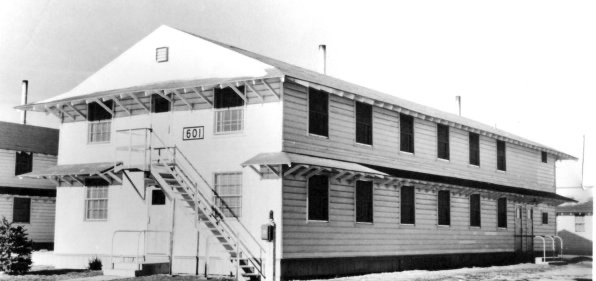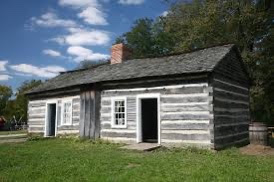The age of pre-fabs and productivity
 |
| Temporary pre-fabs at Syracuse U. They were on nearly every major campus after WW II. |
 |
| The kind of barracks I lived in at Ft. Carson, Colorado. |
 |
| The original home of the Writers' Workshop, 1946 |
They came to mind when Cory Heidelberger did a post in Dakota Free Press on the utilization rate of buildings on the state university campuses. I was struck by the circumstance of living in a time when there was often a frantic search for instructional space and now there is concern about the low degree of use some classrooms are receiving. The temporaries could not be called elegant, but they were functional. When the University of Iowa was dismantling them, a professor expressed regret at seeing them replaced.
He said that they had created an environment for hard work, cooperation, and productivity. As the faculty moved out of them into new buildings, he said that concern about status and social competition displaced the focus on work and discovery. In the old temporaries, professors and students strived to make things work; in upgraded environs, they obsess over their competitive rankings with their fellows. The work ethic that thrived in the modest environment of the old temporaries doesn't survive the transition to classier surroundings, the professor noted.
My experience in the pre-fabs bore out the professor's observation. While in their unostentatious environs, my focus was on accomplishing tasks, and that usually meant engaging in cooperative work with other people. When I became a professor, I was dismayed at how much my colleagues were concerned about who had the most prestigious office space. When I was assigned to an office that was larger than one occupied by a senior professor, he complained and I was ordered to exchange offices with him. Many colleagues seemed to care little about the kind of work they accomplished in the space they occupied. I became one of those professors who was in a campus office only during mandatory office hours when we had to be available to students. To avoid the silly office competition, I did most of my work at home.
As a journalist, I covered companies that, as they became successful, moved into new and lavish quarters. A frequent complaint was that workers became more concerned with how their status was reflected by their office space than with their work. My status-conscious colleagues who vied for the nicest offices were doing what people do in organizations.
A plant manager whose production facilities were moved from an old industrial area to a new "pretentious" setting said that productivity dropped when workers were put into their fancier space. He said that in the older location, workers organized the space around them to get the work done efficiently and excellently. When they moved to the new, swanky building, they became more competitive about how they ranked in the company and displays of privilege and importance. The manager said there was a noticeable change in behavior. At the old building, they solved problems through collegial and productive dialogue. In the new place, communication often became displays of who had the most authority, who thought they knew more, and how well connected they were with the bosses. The effort to do productive, quality work was displaced by a quest for status.
When the company was creating a new line of the machines that it made, the plant manager established a task force of engineers, industrial designers, manufacturing engineers, and customer service specialists to work out the transition to the new line. He moved the task force from the new plant building to an old house on an experimental farm where the company tested its equipment. He said the no-nonsense work setting induced a more intensive focus and productive attitude in the task force. While the workers had all the technological and informational resources to do their jobs, the setting was geared toward work. Status and bureaucratic politics were forgotten for a time.
The farm house had long been converted to office and work space. The dining room with a huge table was a conference room in which the task force gathered and consulted as it carried out its work. Other rooms had been remodeled into offices with desks, drafting tables, computer terminals, and the like, but the work space was organized for work and communication, and not according to rank of authority and status. When members of the task force needed to think and contemplate the work, they could go to their office space or take a stroll along the lanes of the farm. But the space did not reflect any bases of authority or degrees of rank. The plant manager said the task force was the most successful group he had experienced. After the working group returned to its offices, the company used the farm house when it had special and difficult projects to get done. The manager said the setting changed the way workers thought about their jobs and the work they did.
I am not suggesting that companies should abandon the architectural marvels that some make their headquarters when they become successful. But corporations cling to feudal ways in their operations. They have royalty of various ranks who preside over the lives of vassals, the working people. Swank environs and badges of privilege do not
 |
| A reconstruction of Lincoln's birthplace in Kentucky. |
Our national history makes much of the fact that Abraham Lincoln was born in a log cabin and raised in a series of similar homes. The story of his childhood is one of the struggle to find and develop talent in austere settings. Lincoln lost his mother when he was nine. She died after a time when the family moved and lived in a shelter made of logs and branches that was open to the weather on one side. When his father remarried, he gained a stepmother who encouraged him in his reading and efforts to create a life for himself. Lincoln resented that his father took the wages Abe earned as a farmhand and rail-splitter, but he maintained a close relationship with his parents and assisted them in building a new cabin. Lincoln had a perspective on housing that was far from it being a status symbol: "Let not him who is houseless pull down the house of another, but let him work diligently and build one for himself, thus by example assuring that his own shall be safe from violence when built."
 |
| The cabin Lincoln's parents built in Illinois. |
Lincoln saw houses as places that enabled life and work. Their purpose was to support the efforts of humankind, not be the objective of those efforts: "Labor is prior to, and independent of, capital. Capital is only the fruit of labor, and could never have existed if labor had not first existed. Labor is the superior of capital, and deserves much the higher consideration," he said.
When the plant manager moved the task force to work in the farm house, he was reasserting the primacy of work and human effort over ostentatious displays of what it can produce. The problem he saw was that the new plant was designed to reflect the success of the company and to project an image of superior wealth and power. The deployment of the workers fit that pattern, and they engaged in competitive behaviors that were often geared toward personal advancement rather than work which contributed to a collective effort. When they were in the old farm house, their concentration shifted back to the work they were to do.
In an interview of the plant manager after he retired, and he said that when his division of the company moved into a new plant the culture changed. The company liked to show off the architecture and technology of the new building, so it had a stream of tours coming through the plant. The workers responded as if their primary duties were to put on a show for the tourists. Getting them to concentrate on the job of creating and manufacturing a superior product for the customers became an issue, rather than their displays of self-importance became an issue. While the building was to portray a progressive and successful company, the people inside it weren't living up to the image. The facilities were being used as show cases, and the show displaced the work.
That may well be why some higher education facilities are being under-utilized. The focus is on attracting students and putting on a show of keeping up with the advances of technology, but the actual job of engaging in education that is commensurate with those advances is lagging. And much of that kind of work could be done in a pre-fab. Or a Lincoln log cabin.

1 comment:
Excellent analysis of many subjects. As a union guy this stood out, paraphrasing Lincoln. "Without laborers there would be no wealthy owners."
Post a Comment